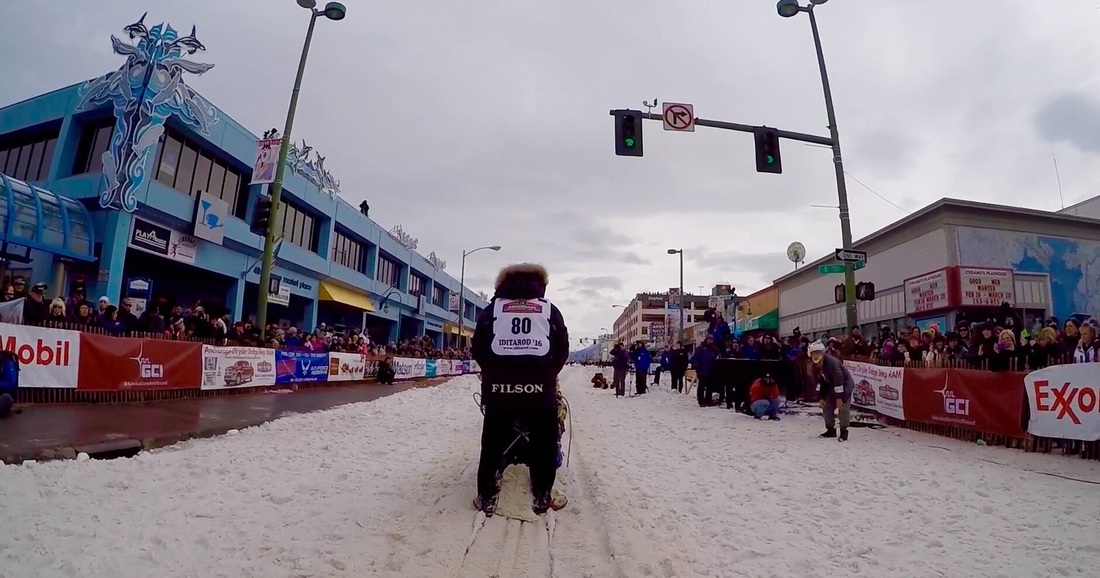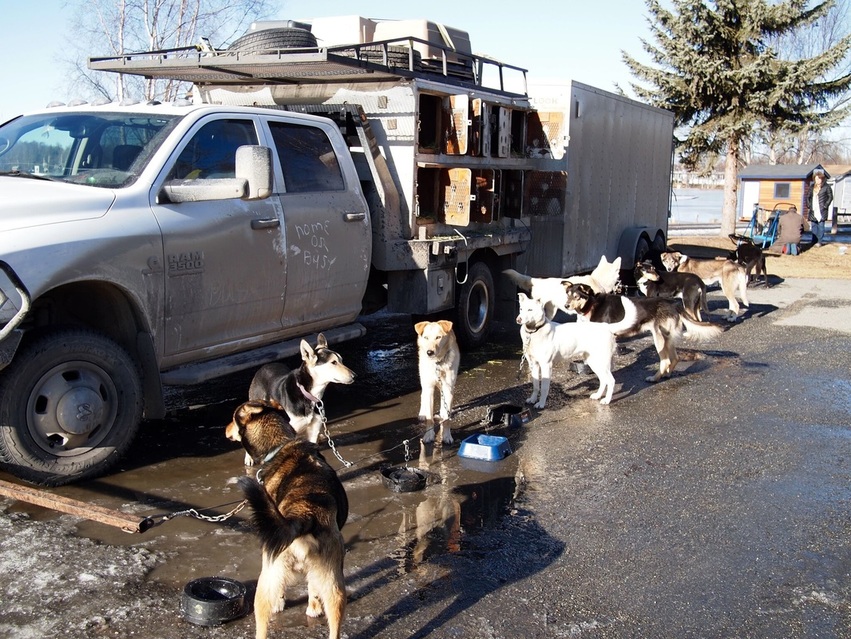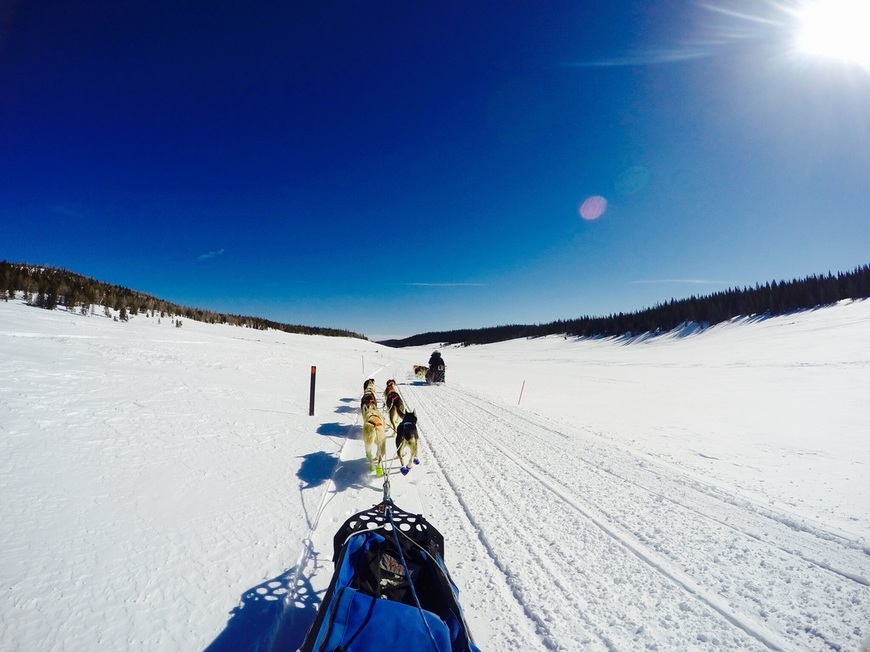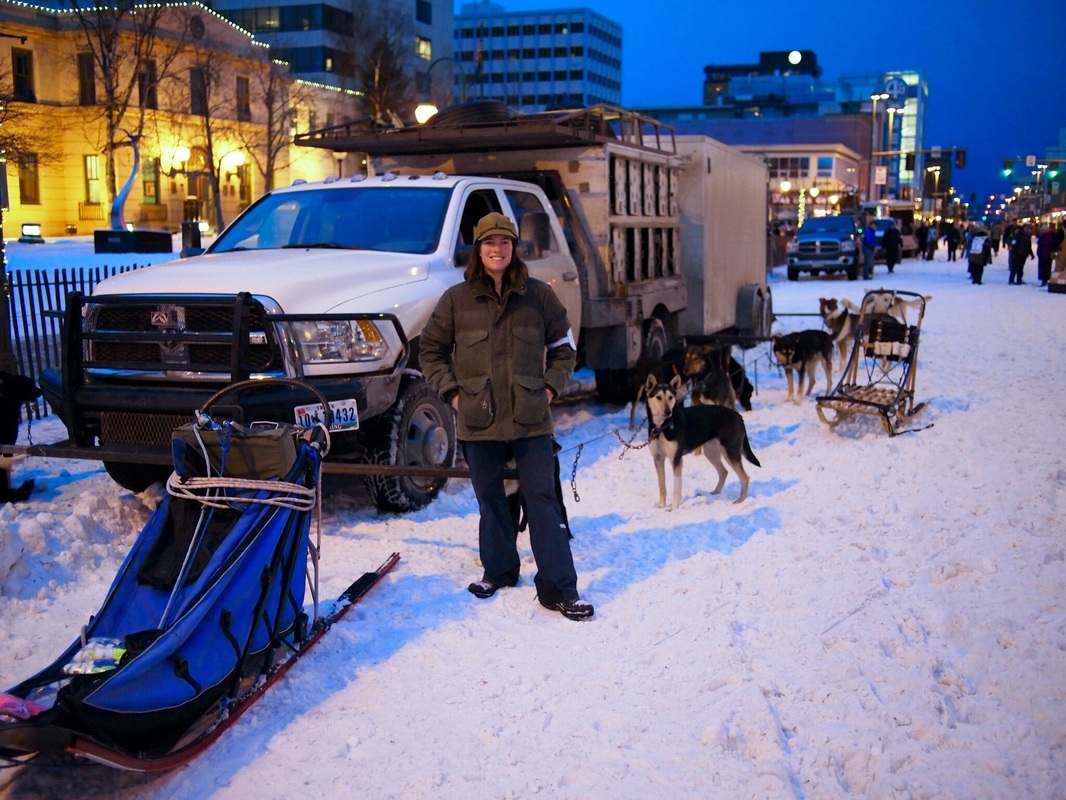|
By Dana Grant On March 6th the best dogsled mushers in the world gathered on a frozen lake in Willow, Alaska for the start of the 2016 Iditarod, “The Last Great Race on Earth.” I was there to support musher #80, Billy Snodgrass, my good friend and boss from my previous winters as a dogsled guide. After years of breeding and training, a six day road trip and a few hectic moments of helping to hold back a very strong dog team, it all boiled down to a few memorable seconds as I watched Billy fly over the start line in pursuit of his 5th Iditarod finish. Nearly 1,000 miles through the remote, rugged and beautiful terrain of Alaska, the finish line awaited. Now that Billy was safely underway I took a deep breath and looked around. The spirit of the race was in the air. Spectators on foot or with snowmobiles had gathered for miles along the icy trail to wish the mushers well. All the legendary champion mushers were there, Jeff King, DeeDee Jonrowe, Lance Mackey… Yet something felt off. Was it the glaring sun and warm temperature? Here at the start of a race known for devastatingly cold conditions and adverse winter weather, even my light sweater felt unnecessary. As I packed the truck and trailer, an ominous warping sound rose up from beneath my feet. The weight of the vehicle was stressing and cracking a weakened layer of lake ice below the surface; yet another sign that this year's winter in Alaska hadn’t been much of a winter at all. Dick Wilmarth won the first Iditarod in 1973 with a time of 20 days, 49 minutes and 41 seconds. This year Dallas Seavey won the Iditarod for the 3rd time with a time of 8 days, 11 hours, 30 minutes and 16 seconds. Even the final musher to cross the finish line this year beat Wilmarth’s time by more than 6 full days. A lot has improved in dogsled racing that accounts for this speed. The selective breeding of the dogs, better harness and sled design, a better understanding of canine nutrition and supplement are all factors. But I suspect there’s another simple factor involving our changing climate: an absence of fresh, deep snow to push through. The Iditarod kicks off with a lively Ceremonial Start in downtown Anchorage. Mushers parade their teams down 4th Ave., then they take off on a fun run through the city streets specially covered with snow reserved from the winter street plowing. Race sponsors and guests of honor ride along in the sled and high fives are generously distributed to the children and fans lined up along the route. It’s a fantastic celebration of this traditional and truly Alaskan event. This year however, the snow reserves were lower then ever before. Alaska Railroad stepped up to save the day by volunteering to haul in train cars full of snow from Fairbanks. Unfortunately the condition of this imported snow, littered with rocks and debris, made the majority unusable. Ultimately the route for the ceremonial start was shortened from 11 miles to a mere three. The start in Willow was also a compromise planned by the race committee, as the lack of snow made the traditional trail out of Anchorage impassible. Warming weather has plagued other recent Iditarod races. In 2014 bare trails along the route caused injuries and broken sleds. In 2015 the race was forced to move the starting line 225 miles north to Fairbanks. Mushers and sled dogs are notoriously tough and adaptable and the Iditarod is a race that thrives on challenge. The difficulty of frigid temperatures and blinding blizzards are rapidly being replaced with the struggle of too little snow on the trail, unusually high temperatures that cause the dogs to dehydrate and open water spanning a trail that should be solid ice. Germs also seemed to thrive in the warm conditions along the trail this year. Many dogs and mushers suffered from viruses and illnesses contracted on their journey. Unfortunately, Billy and his team had to scratch and resign from the race in Unalakleet after running more than 700 miles. His dogs caught an intestinal bug that made them too weak to continue. This is always a risk when dog teams travel from various locations to share a race trail. No doubt the Alaskan teams benefited from immunity to local maladies that our Wyoming dogs lacked. But it does make me wonder how the health of plants, animals and people will be affected as more and more parts of the world begin to loose the frigid, pathogen-killing temperatures that have existed for ages. 2016 marked the first time in at least 100 years that no place in Alaska recorded a temperature of -50 degrees or lower. Perhaps the greatest testament to the changes occurring came from my conversations with the local people I met along the way. My taxi driver in Nome, a tiny village along the Bering Sea where the finish line lies, told me how his father had hoped one of his sons would inherit his line of sled dogs. But they had no interest. They all turned to snowmobiles and became mechanics instead. This trend has taken hold in all the villages and is reflected in the growing popularity of another Alaskan race; The Iron Dog. This is a 2,000 mile race run on snowmobiles powered by fossil fuels, not dogs. When I arrived in Anchorage to collect the dog truck, I rode with a shuttle driver who told stories from her childhood in a remote village. We smiled and laughed as she told me about her adventures trapping and racing with her father and his dog team. “It sure was fun. But that was before, back when it really used to snow. We never had TV and things in the village, we didn’t need them. Now things are different, everyone needs cars and phones and things. Even me, I’m one of those people now, I wonder what my father would think if he could see me now?” We’re all a part of the change, reliance on modern technology and fossil fuels has made most everyone an accomplice in the compounding forces of climate change. I was acutely aware of my own contribution to the problem as Billy, the dogs and I loaded up and began to travel thousands of miles back to Wyoming in a big diesel truck. On our journey south I gazed out on the black spruce and pine wilderness of the Yukon and Kluane National Park. The area is populated with vulnerable species like moose, elk, wolves, caribou, lynx and wolverine. Seeing such a huge swath of wilderness relatively untouched by man and machine was inspiring but the concern for our climate was heavy on my mind. In my role as competition coordinator here at the Jackson Hole Wildlife Film Festival, I am constantly reminded of the peril facing our planet and its wildlife. Even on my adventure away from the office I couldn’t escape this concern. We are at a crux; the signs are all around us. All that we stand to lose is obvious, but the solution is more evasive. How do we remain aware, yet optimistic, and continue to work towards the preservation of the natural world? It’s a choice we must make everyday. I can only hope that as our impact and its repercussions become more and more apparent, that more and more people will wake up and make that choice. Iditarod and Iditarod-The Last Great Race on Earth are registered trademarks of Iditarod Trail Committee, Inc.
1 Comment
Dave Eubank
2/27/2018 01:12:27 pm
I wrote an essay in 2001 on the Iditarod for my English class at UAA and titled it: "A Race against Time." I maxed it out after I sustained a brain aneurysm in 1998
Reply
Leave a Reply. |
Archives
March 2024
Categories
All
|
Contact UsJackson Wild
240 S. Glenwood, Suite 102 PO Box 3940 Jackson, WY 83001 307-200-3286 info@jacksonwild.org |





 RSS Feed
RSS Feed